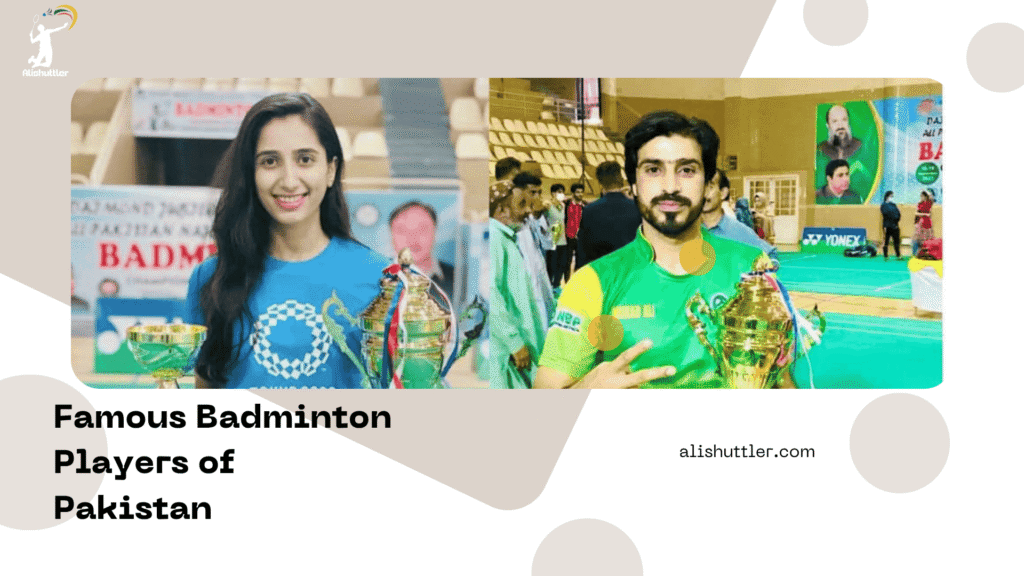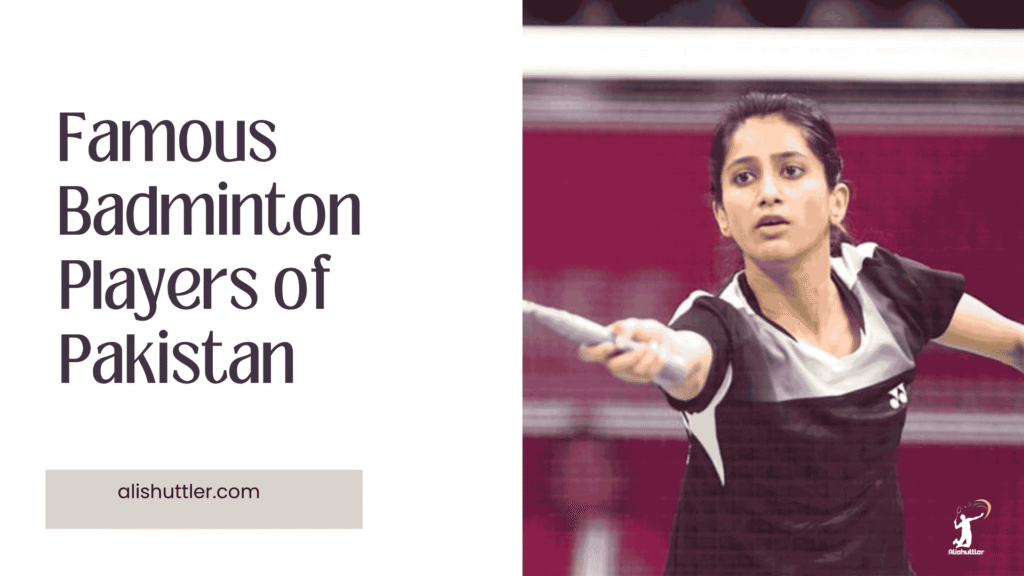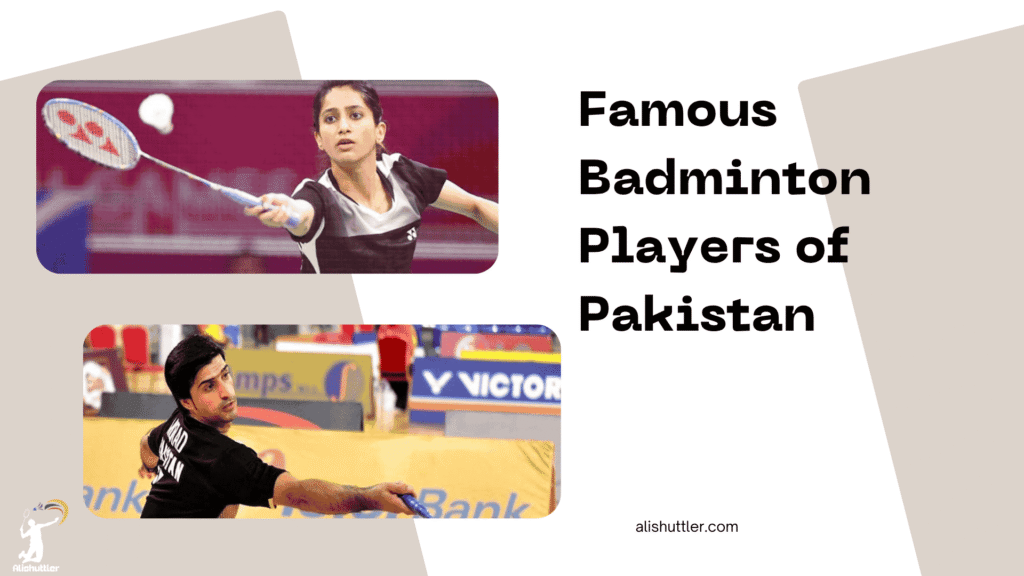Badminton players of Pakistan include a list of notable men and women who played national and international-level matches. Several made it to the finals in the SAG and Asian championships.
Some of the popular names are Mahoor Shahzad, Murad Ali, and Palwasha Bashir. Their victories introduced a broader audience to the sport within the nation.
This post chronicles their careers, biggest matches and how they helped shape badminton in Pakistan.
Pakistan’s Shuttlers
Pakistan’s badminton players have a long and steady history, both at home and on the world stage. The national badminton team, formed in 1953, has sent many shuttlers to global contests. They joined the Sudirman Cup, which is the world’s main mixed team badminton event, in 1993, 1995, and 1997. Each time, they played well but did not get past the group stage. Still, these early steps showed Pakistan’s interest in the sport.
During the 1960s and 1970s, Mahboob Khan was the standout player, often seen as the backbone of Pakistani badminton in that era. Javed Iqbal left his mark, winning the national title six times through the 1970s. In 1982, a Pakistani player beat Syed Modi, the Indian champion, at the German Open. Modi later won Commonwealth gold, so this win showed Pakistan’s skill on the court.
Tariq Wadood stars in this tale. He had shone in junior events and made the quarter-finals of the Nationals open round. After this, he was urged to specialize in senior-level games. Wadood’s career shows his determination to inject innovation and expansion into the sport. His accomplishments, efforts, and influence are most poignant in the table below.
| Achievement | Details |
|---|---|
| Junior Event Success | Reached quarter-finals in Nationals open round |
| Transition to Seniors | Advised to shift focus to senior events after strong junior showing |
| International Presence | Helped raise awareness of Pakistani badminton abroad |
| Mentorship | Supported younger shuttlers in training and career development |
Mahoor Shahzad is Pakistan’s best lady shuttler of late. Born in 1996, she has played in many global events and reached a ranking of 354 in women’s singles. Her emergence symbolizes increased encouragement for women’s sports in Pakistan. Mahoor’s impact both on and off the court has motivated young players, particularly girls, who look up to her as a role model.
Her fast and focused play style helped her outlast top players from dozens of countries. Palwasha Bashir has been crucial to Pakistan’s national team. She’s got a killer instinct and supports her team members. Her commitment has raised the team’s morale and raised the standard for regional competitions.
She is known to bring out her best in team events, displaying her mettle. Rizwan Azam is another notable name. His strong play and victories have helped increase the sport’s popularity in Pakistan. Rizwan’s passion and expertise have attracted many more youngsters to badminton.
He’s been instrumental in local outreach, conducting clinics and coaching sessions to develop the next wave of talent.

1. Murad Ali
Murad Ali is an anomaly in Pakistan’s badminton sphere, not just for his success, but for his quiet consistency at the pinnacle. At 34, hailing from Peshawar, he has been a mainstay for the past eight years.
2. Mahoor Shahzad
Mahoor Shahzad has dominated in national championships, frequently taking gold or silver. She is known for her emphasis on skill-building — a hard-nosed discipline, practicing for hours every day.
Mahoor’s schedule frequently features endurance workouts, on-court tactics practice, and physical training to remain in top shape. She has paved the way for young women in badminton.
She proves that with work, women athletes can achieve the same level as men. She attends public events and speaks about her journey to inspire girls to pick up the sport.
Mahoor’s impact takes more than the court—she’s helped shine a spotlight on Pakistani women’s badminton and encouraged a lot of others to pursue it.
3. Palwasha Bashir
Palwasha Bashir is a singles and doubles player who has won multiple national titles. She’s got quick reflexes and a knack for reading her opponents that helps her pull out points in tight matches.
On court, Palwasha utilizes a combination of quickness, nimble footwork, and strategic positioning. She frequently dominates rallies with her backhand and holds her nerve under pressure.
Off the court, she returns by coaching at community clubs and running clinics for novices. Her grassroots work helps bring the sport to new players.
She’s now a revered figure within Pakistan’s badminton community, being applauded for her dedication and fair play.
4. Rizwan Azam
Rizwan Azam has an impressive record with strong tournament performances, including regional and international appearances. He’s short, but recognized for his mental toughness and match focus.
He adjusts his approach against hard hitters, mixing up pace or shot selection to disrupt his opponent’s timing. Junior players admire him, and he mentors at badminton camps.
Rizwan backs the Pakistan Badminton Federation, enhancing its training and scouting efforts.
5. Irfan Saeed Bhatti
- Multiple national doubles and singles titles
- Represented Pakistan in South Asian Games, Commonwealth Games
- Mentors emerging athletes and coaches at club level
- Known for aggressive net play and tactical defense
He stays engaged in major events and leads by example.
Global Titans
The sport’s landscape is defined by a handful of countries and players who establish the benchmark for talent, tactics, and influence. These global titans rule the courts and make an indelible impression on the game and its cultural impact.
China, Indonesia and Malaysia dominate the world of badminton in the same way the global titans dominate economics and politics. Their athletes and a handful of other countries’ stars set the pace that juniors – like the Pakistanis – aspire to emulate.
World’s Best
- Viktor Axelsen (Denmark) – World No. 1
- An Se-young (South Korea) – World No. 1 (Women)
- Chen Yufei (China)
- Anthony Sinisuka Ginting (Indonesia)
- Lee Zii Jia (Malaysia)
- Mahoor Shahzad (Pakistan) – Top Pakistani women’s singles
- Murad Ali (Pakistan) – Top Pakistani men’s singles
Axelsen’s trademark defense and big smashes. An Se-young beats in agility and sharp net play. Lee Zii Jia delivers pace and smart shot positioning.
Mahoor Shahzad is known for her tenacity, reflexes on the court while Murad Ali is famous for his controlled technique. These players have sealed medals at the Olympics, All England Open and BWF World Championships.
Their victories have elevated badminton into the global sports conversation. Their impact transcends positions. In raising the bar, they motivate not only players from badminton powerhouses, but nations still striving to make an impact, like Pakistan.
Playing Styles
The world’s best badminton players display contrasting characteristics. Others rely on precision and patience to pulverize their adversaries.
Top players blend attack and defense. They employ needle net shots, trickle drops and booming clears. They typically feature a mixture of aggressiveness and control.
Every match is a grueling mental and physical gauntlet. Playing styles can give the edge in tight games. Blazing, unforgiving rallies or cautious, calculated point construction frequently determine who makes the cut in tournaments and who sinks in the rankings.
Over the years, badminton has evolved from an all out speed sport to more tactical game play and fitness. This introduced new training regimens and a more expansive skill portfolio to the world’s elite.

Major Titles
- Olympic Gold Medal – Sets the ultimate benchmark for achievement.
- All England Open – Historic and prestigious, it’s often referred to as the “Wimbledon of badminton.”
- BWF World Championships – Crowns the world champion each year.
- Thomas & Uber Cups – Team events that showcase national depth.
It is winning these titles that is so important for legacy. Olympic and World titles make a player legend. The All England Open is legendary and revered.
Of course, team trophies such as Thomas and Uber Cups demonstrate national prowess. Big tournaments are competitive. Only the best adapt and win at this level.
Wins drive rankings and provide access to worldwide sponsorships. Those players who hit it big become household names and role models.
Historical Icons
Badminton’s international legacy is defined by extraordinary icons whose impact extends well outside the court. These players, with their records and individualistic style, have inspired generations and made the game more popular internationally. They join the likes of Indonesia, China, Denmark and others who have established themselves in the sport.
Lin Dan
There’s a reason they call China’s Lin Dan “Super Dan.” He captured two Olympic golds (2008, 2012) and five World Championships – leaving him the only player to achieve the ‘Super Grand Slam’ of all nine major badminton titles. His tactical shots, incisive footwork and mental toughness distinguished him.
Lin’s game was not merely about pace but anticipation and timing the right shift in gear. He revolutionized how players and coaches consider match preparation and defense. Even today, countless young athletes emulate his regimen of zeal and concentration.
Lin Dan’s longevity in world rankings and his iconic duels with top rivals made him a figure of perseverance and genius. He set a new standard for what it means to be a world-class athlete.
Lee Chong Wei
Lee Chong Wei of Malaysia was world number one for a record 349 weeks. He took silver at three Olympic Games and amassed more than 45 BWF Super Series titles. His battles with Lin Dan are the stuff of legend, regularly attracting millions of viewers across the globe.
Every meeting took them both to new heights, demonstrating the value of rivalry in competition. He inspired a generation of Malaysian players, making badminton a household moniker in his country. His influence extends across Asia, assisting the game’s expansion in countries such as India and Thailand.
Lee’s lead raised the level of training and competition. It made Asian badminton better and more prominent globally.
Taufik Hidayat
Taufik Hidayat from Indonesia, Olympic gold winner in 2004 and 2005 World Champion. He possessed a backhand smash that few could equal, and his skill in altering the pace during rallies surprised many. Even today, coaches play his matches to illustrate master techniques.
He was instrumental in preserving Indonesia’s badminton heritage in the years following the team’s Thomas Cup victories. His style and charisma made him a role model in SE Asia. He demonstrated to youngsters that brains and brawn can triumph as much as biceps.
The Ecosystem
Badminton in Pakistan perches inside a wider sporting ecosystem, sculpted by history, culture, and socio-economic forces. The sport’s expansion mirrors shifts in infrastructure, community support, and institutional support. Its evolution requires grassroots activity, improved practice venues, and tighter partnerships between public and private entities.
The current state and potential for growth can be summed up as:
- Limited but steady player participation across urban centers
- A handful of state-of-the-art courts, but most can still depend on the dirt and basic facilities
- Growing public interest, especially among youth
- Patchy talent pipelines due to inconsistent grassroots programs
- Rising calls for sustainable investment and long-term planning
- Untapped international exposure for top players
Grassroots Level
Grassroots programs thrive as the initial step in player cultivation. They assist in discovering and developing youth talent, usually at schools or community clubs. These initiatives are important. They help provide access to sport, transcend social boundaries and cultivate a culture of play.
Some cities have established youth leagues and school competitions, producing stars such as Mahoor Shahzad and Palwasha Bashir, who both emerged from the local setup. Yet, many areas do not have organized activities or monies. Coaches have little resources and many young players drop out because of costs or no family support.
Obstacles consist of cultural attitudes towards sport, limited kit and minimal exposure outside major urban centres. Without solid grassroots, talent lies fallow, unspotted and uncoached. To increase participation, additional school partnerships, free clinics and community tournaments can assist. Local businesses and civic groups could sponsor events, and retired players could mentor youth.
Training Facilities
Most badminton training halls in Pakistan are rudimentary, with tattered floors and old-fashioned nets. There are not many international-standard venues, which restricts player development and complicates organizing major competitions. Good training sites are few and far between outside of large metropolitan areas.
Even in Karachi and Lahore, however, court time is scarce and equipment is frequently communal. Wood-floor modern centers with proper lighting and fitness rooms would elevate performance. Upgrades might attract superior coaches and allow athletes to practice all year long.
Some private academies have started to fill the void, providing players like Murad Ali exposure to structured programs and improved gear. Good facilities communicate to international federations that Pakistan is ready for elite matches. It adds freshness and allows local players to pit their skills against elite competition.
Systemic Hurdles
- Few sponsors and small budgets
- Hard-to-find gear and coaching
- Little media coverage
- Sparse research and data
- Policies rarely updated
Funding gaps prevent numerous players from participating in tournaments or purchasing shoes and rackets. Without support, even the most gifted flounder in their quest to reach the next level. These obstacles impede skill-building, crush motivation, and keep Pakistan off the world stage.
Fixes range from transparent financing schemes, frequent rule revisions, to increased collaborations with civil organizations. Making player and training data public enables coaches to plan better.
Official Support
The Pakistan Badminton Federation organizes competitions and establishes regulations. Its work can elevate or constrain the game. Government measures like constructing new halls or providing travel grants have assisted, but advancement is sluggish.
Sponsorships matter the most. When brands support a player or event, they bring funding and focus. Working with more partners—schools, NGOs, local firms—could spread costs and inspiration. Defined roles and objectives keep everyone pulling together.
Cultural Standing
Badminton in Pakistan has a rich and long history, as the country’s team was established in 1953. As a sport, it occupies a special place in the nation’s cultural standing. It’s not cricket or field hockey, but badminton’s never been more respected or visible — particularly in cities and with younger audiences.
Public Perception
To the public at large, badminton is a backyard game, nothing more. A lot of people are aware of their Olympic culture, but not so much the local accomplishments. Yet this perspective is changing, particularly in urban environments.
Out in the city, perceptions of badminton are changing. With infrastructure like local clubs and indoor courts popping up, more people are starting to view badminton as a legit sport. Families have children join, looking for new careers.
Successes are altering this perception — from Mahoor Shahzad making her Olympic debut to becoming a four-time national champion. From the streets to her story, anyone can dream big in this game. Whenever players such as Shahzad go out there and win abroad, it shines a light on the sport back home.

It helps stir community pride and encourages more young people to grab a racket. For increased exposure, professionals recommended additional school programs, expanded television coverage, and consistent national tournaments. Neighborhood games and teen outreach can continue to span the spectrum between pickup and pro.
Media Spotlight
Media coverage has been a mixed blessing. Old-school news media will seldom report on badminton-type events outside of a domestic or global victory. When Mahoor Shahzad went to the Olympics, however, the media coverage picked up, hinting at the possibility of wider coverage.
A few campaigns have featured her journey and the national team competing abroad, generating buzz among all ages. Social media trumps print or TV for younger fans. They post and share scores, training clips and inspiring stories of Pakistani athletes out at global tournaments.
This digital exposure has put international training camps, such as Malaysia’s AOP camp, on the map. With more specific campaigns and regular updates from the Badminton Federation, it could get even more interesting!
It can increase media engagement with investments in documentaries, live streaming tournaments and athlete profiles. These measures would demonstrate the sport’s advancement and resonate with fresh audiences.
Untapped Potential
Untapped potential refers to the unused talent and resources in Pakistan’s badminton scene. Even though they are talented, motivated and have potential to succeed, they still encountered barriers such as insufficient financing, no access to world-class coaching and minimal support infrastructure. Consequently individuals and teams flounder to hit their best.
We’ve got a genuine opportunity to construct even sturdier foundations and open some breakthrough entryways, paving the way for Pakistani badminton to step from potential to performance.
Private Leagues
Private leagues are revolutionizing player development in Pakistan. At their inception, private leagues provided both rookie and veteran players a venue to play, develop and compete outside the conventional system. They tend to play more games, have higher quality coaching and attract sponsors eager to invest in homegrown talent.
Leagues in India and Malaysia have demonstrated how this model can work—both lifted national performance and expanded fan passion. Private leagues are more than just games. They contribute to raising the bar by pushing players to practice harder and play smarter.
More matches = more opportunities to make and correct errors. Private league/national federation partnerships may accelerate development by pooling resources, maintaining talent pipelines and importing elite coaches from abroad.
International Exposure
International tournaments provide Pakistani players with a unique opportunity to meet new opponents and absorb new strategies. When players go abroad, they encounter different styles and higher levels of skill. This in turn helps them hone their own game, identify holes and develop mental armor.
International experience teaches them how to adapt quickly when things shift on court. Playing on the international stage isn’t easy. It requires investment, organization, and assistance from public and private organizations.
Nations such as Japan have dispatched young squads to minor international meets in advance of the majors, conditioning players to pressure. More assistance in travel and visas, and links with international clubs can open more avenues for Pakistani players.
A New Narrative
Badminton in Pakistan deserves a new narrative—one that shines a light on its potential. We should be broadcasting success stories, even tiny or little ones, in schools, online, in the news. Community events, school visits and social media can help change minds and bring in more people.
Because when it’s positive and real, it will attract sponsors and fans and new players. This shift can help grow the sport and make sure untapped potential doesn’t go to waste.
Conclusion
Pakistan has its own queue of scrappy shuttlers dreaming big. Players such as Murad Ali for grit and skill. It has a legacy with legends who returned pride home. The sport’s world stage seems enormous, yet fresh names just keep emerging. Hundreds of youngsters grab rackets on tiny courts, with a lot of optimism.
Our local scene still has room to develop. More backing equals more victories, and that equals more kids on the court. To witness more Pakistani talent, fans and organizations can stand up, cheer and assist. To maintain the momentum, hang with the sport, tell the tales and support the warriors still battling for their position.
Frequently Asked Questions
Who are the top badminton players from Pakistan?
Amongst Pakistan’s top players are Murad Ali, Mahoor Shahzad and Palwasha Bashir. They have won accolades for Pakistan in regional and international tournaments.
Has Pakistan produced any globally recognized badminton champions?
Pakistan doesn’t have world champions in badminton yet. Players such as Mahoor Shahzad have stepped onto the world stage and elevated the nation’s presence.
What challenges do Pakistani badminton players face?
Pakistani players tend to have scarce funding, reduced access to world-class coach and less international exposure. These challenges could impact their global competitiveness.
How is badminton viewed culturally in Pakistan?
Badminton is popular at the grassroots level in Pakistan, particularly in schools and clubs. It’s not as popular as cricket or hockey.
Are there any famous historical icons in Pakistani badminton?
Legends such as Wajid Ali and Bushra Qayyum have paved the way for badminton’s rise in Pakistan over the years.
What is being done to support badminton in Pakistan?
These efforts encompass national-level competitions, junior development initiatives, and dedicated support from the Pakistan Badminton Federation to cultivate emerging players and enhance infrastructure.
Is there untapped potential in Pakistani badminton?
Yes, with ample underutilized potential. With improved sponsorship, infrastructure, and international exposure, Pakistan’s players could make it big in the world stage.






